
7 minute read
Everyday items tell Gleaner history
The last 128 years reflect many changes, and the Gleaner Frank Dick History Room helps to tell their stories.
To measure the success and stability of groups like Gleaner Life Insurance Society, people might use ratings, assets, or the 128 years since we were founded.
Advertisement
Another way might be with an old ruler, a clock, convention badges, and other items. These help measure some of the many changes weathered by the Society — and society in general — since Gleaner formed in 1894.

This ruler, manufactured in 1936 when Gleaner had existed for 42 years, recently was added to the Gleaner historical collection. Today, Gleaner is approaching its 129th birthday.
The ruler recently was furnished to the Home Office’s Frank Dick History Room. It was used at the three most recent Home Office sites. In the 1960s it was used in the Gleaner Home Office’s keypunch department where computer programming required punched cards. The ruler was manufactured when Gleaner headquarters were in Detroit, and proclaims “42 Years Dependable Life Insurance Service.” That indicates the ruler was made in 1936. Forty-two years was remarkable then. Since then, the Society has protected families for 86 additional years through the end of the Great Depression, World War II, several recessions, and the COVID pandemic. On these pages are some other historical Gleaner items.


Arbor members voted on new members using the blackball method common among fraternal groups in the 1800s. They placed either a white marble to accept the applicant or a black marble to reject them into wooden boxes. (The word “ballot” comes from the Italian word “ballota,” a “small ball for voting” or “secret vote using ballots.” The method using colored rocks dates to ancient times.) Three black marbles rejected, or “blackballed,” an applicant. The voting box could be held over the shoulder to ensure voting would be secret, as this 1977 photo featuring Board of Directors members Leonard Davis and George Leonard illustrates. Arbor members were urged to “think twice before depositing a black ball,” and not to reject anyone for “petty jealousy,” as an 1899 article in The Gleaner stated.
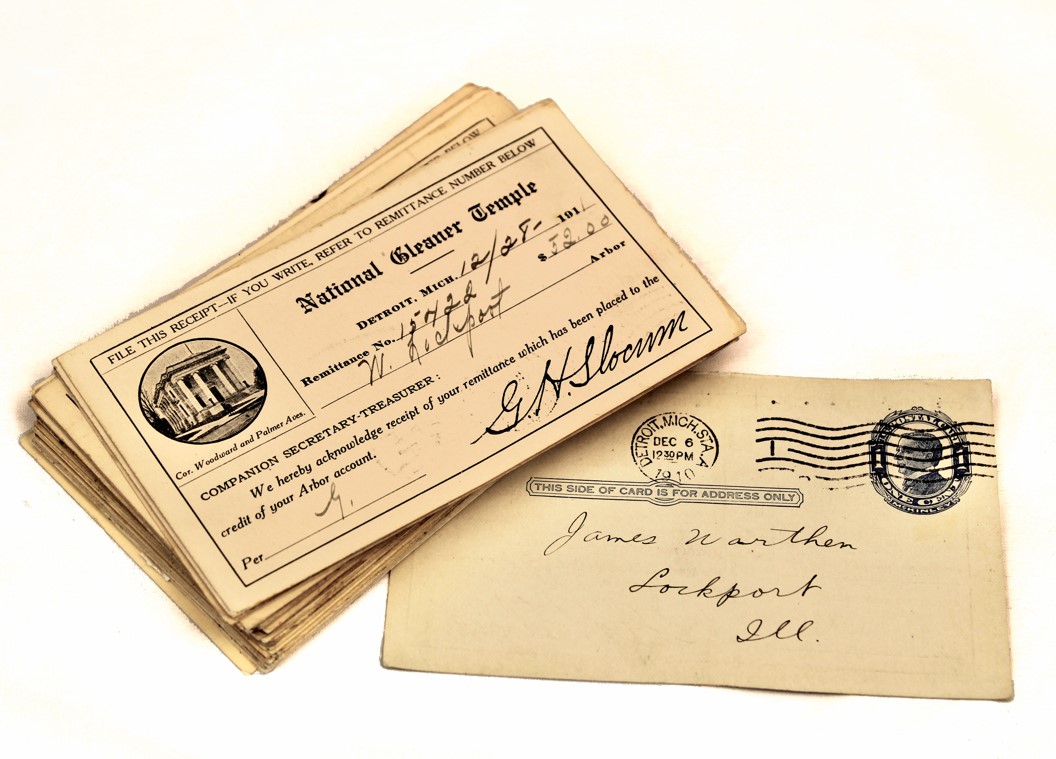
These are old premium receipts mailed to West Lockport Arbor (IL) between 1910 and 1956. They were sent to the arbor’s two Treasurers during that period, James Warthen and William H. Hawes, who took over in 1925. Note that no address was needed for Warthen beyond “Lockport, Ill.” Also note the 1 cent mail. The price doubled to 2 cents in 1952.

A Gleaner clock, available as a membership drive prize around 1902.
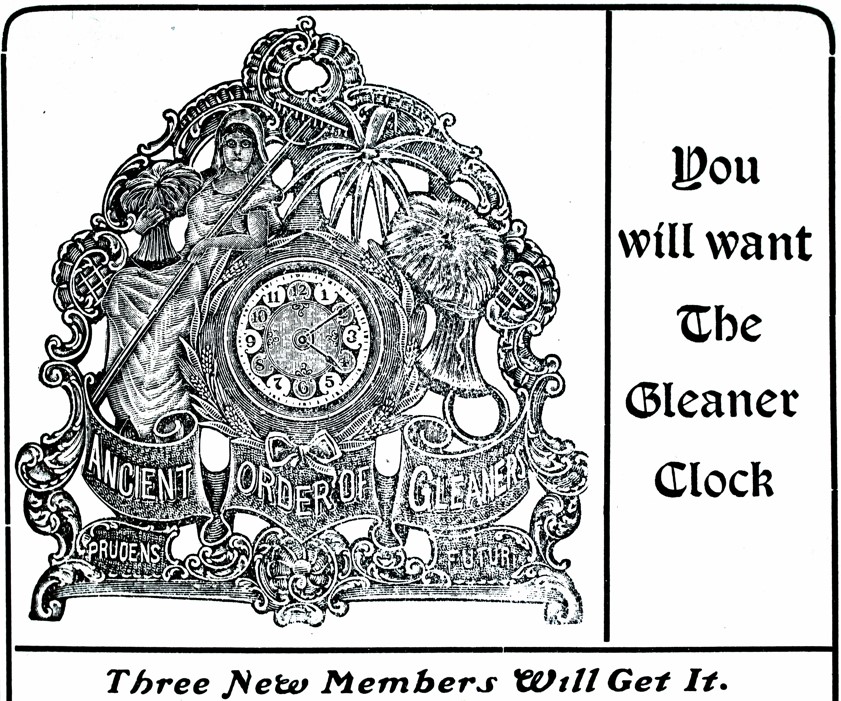
This bronze Gleaner clock originally was offered in 1902, long before digital timepieces. It also is shown in The Monthly Gleaner. It was given as a membership prize prior to when life insurance was handled by licensed agents. The windup clock’s design includes the biblical figure of Ruth holding a sheaf of wheat on her lap, the Society’s name at the time (“Ancient Order Of Gleaners”), and the Society’s motto at the bottom, “Prudens futuri” (“Thoughtful for the future”). The clocks were manufactured by James M. Goodell of Austin, Illinois.

Culture has changed enormously, and smoking no longer is as common. This matchbook was made for Gleaner Life by the Universal Match Corp. of Detroit sometime between 1951 and 1957, when Gleaner Life moved its Home Office out of Detroit.

This 1948 cookbook described itself as “The Gleaners Original Cook Book.” It was produced by Society members who attended First St. John’s Lutheran Church in Toledo, Ohio, and a copy was placed at the Home Office.

This pin at the Home Office is for members of the Junior Gleaner program, which began in 1926. These groups of young members elected their own leaders and had their own meetings. Many of the early Junior Gleaners later served in World War II.
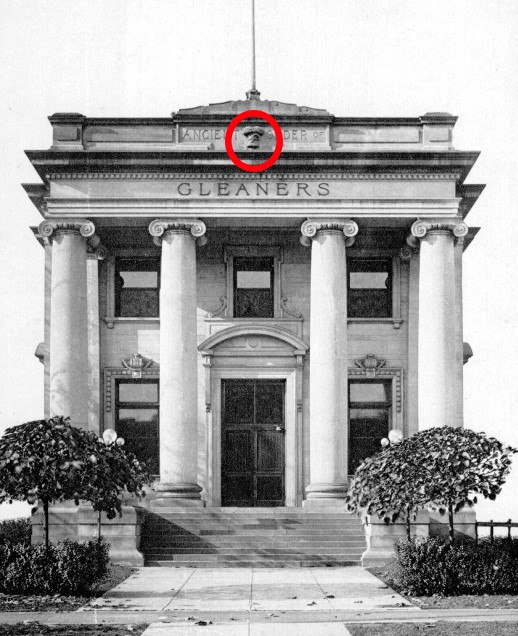
The Gleaner headquarters built in 1908 in Detroit included a concrete medallion above the word "GLEANERS." It featured a wheat sheaf and a sickle.

The medallion was saved and moved to the new Home Office in Adrian, Michigan, before the old building was demolished.
Two of the Gleaner symbols — the wheat sheaf and the sickle — were included in a concrete medallion placed near the top of the Gleaner Home Office when it was built in Detroit in 1908. The building was sold when Gleaner moved operations to Birmingham, Michigan. Before the building was torn down in 1997, the wheat sheaf and sickle were saved and moved to the Home Office in Adrian.

The award-winning Kankakee Arbor (IL) Women's Drill Team was shown in 1939.

One of the drill team uniforms was donated to the Home Office.
Uniforms and costumes were used by several Gleaner groups. The Kankakee Arbor (IL) Gleaner Women’s Drill Team was one of the best known, especially during the 1940s. This uniform was donated by the arbor to the Home Office in April 1985.
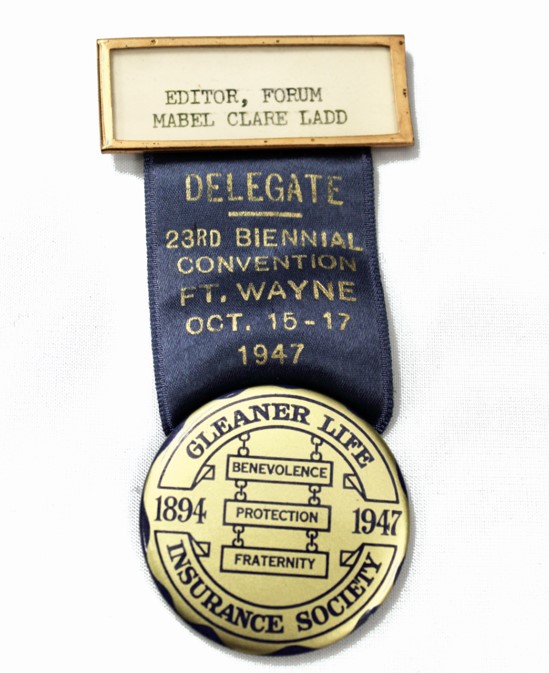
This delegate badge was worn by Mabel Clare Ladd (below), who served the Society for 52 years beginning in 1903.

This delegate badge was worn by Gleaner Forum editor Mabel Clare Ladd at the 23rd Biennial Convention held in 1947 in Ft. Wayne, Indiana. Ladd worked at Gleaner for 52 years starting in 1903. Her career spanned the eras of horses and wagons to the jet age, and she compiled Gleaner history documenting much of its first seven decades.
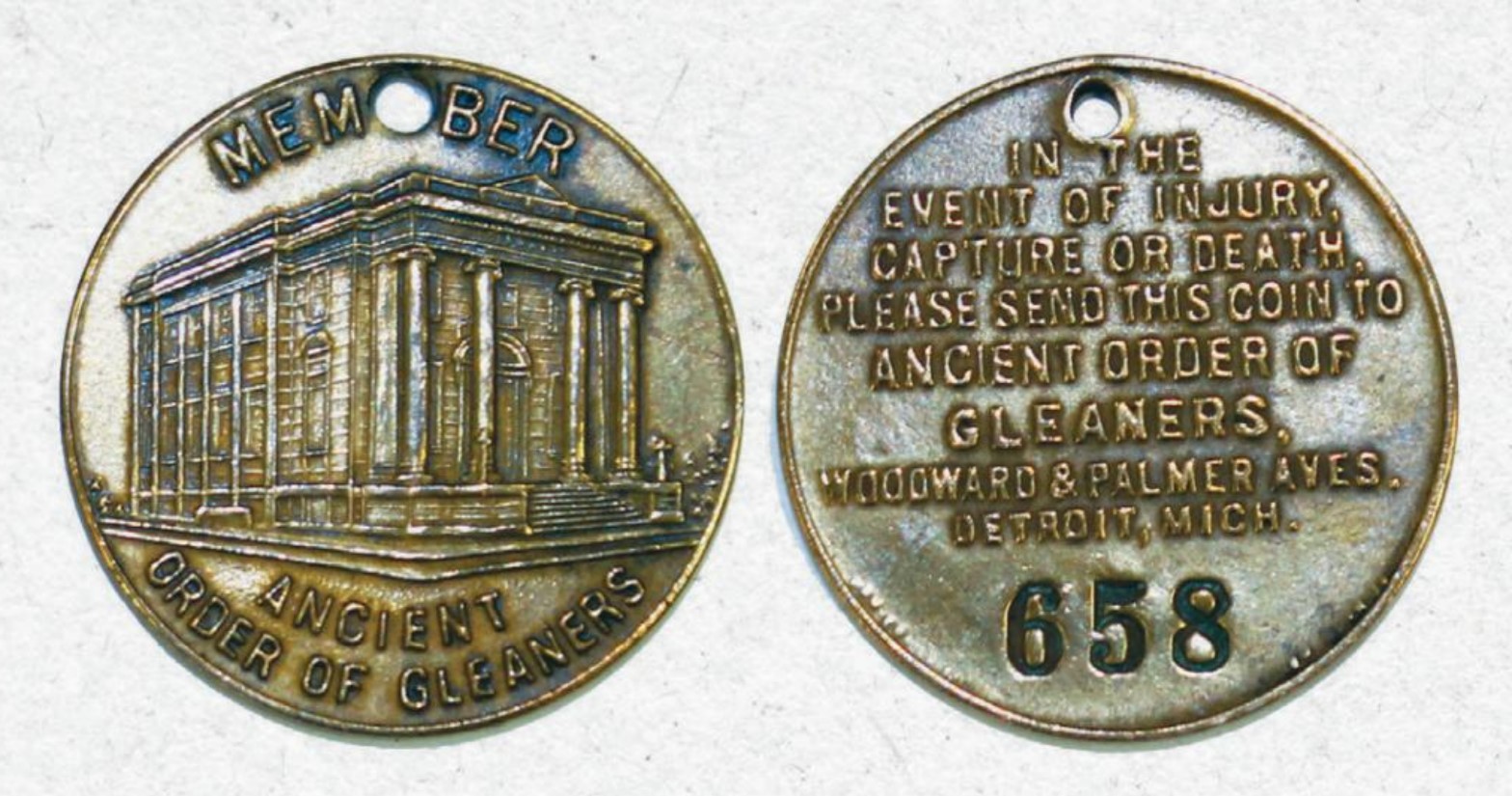
Special identification coins like this one were issued to members serving in the U.S. armed forces in World War I. A total of 104 Gleaner members were killed in the war and, despite many having war exclusion clauses in their policies, the Society agreed to pay all of them.
When the U.S. entered World War I in 1917, the military did not use a common identification method for all servicemen. Worried that some might be killed and never identified, Gleaner responded by issuing members in service a special ID coin. Each was numbered and had instructions for contacting the Home Office in Detroit. These were closer in size to the “dogs tags” the military eventually adopted prior to World War II.
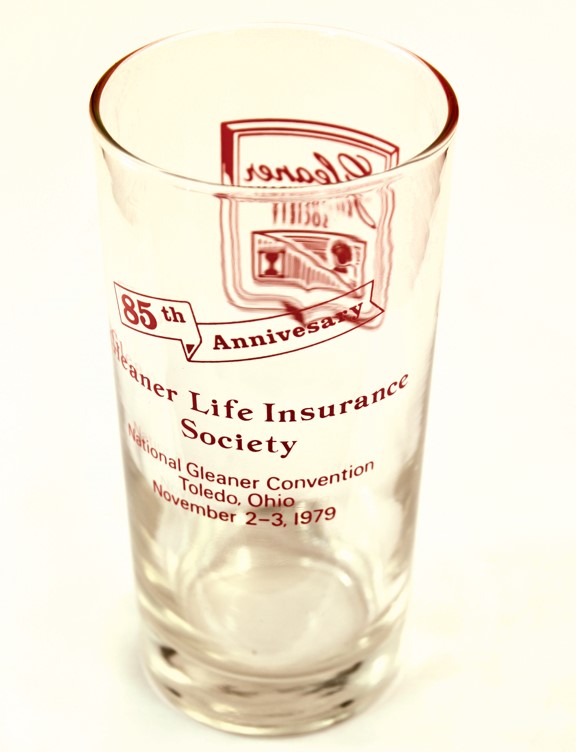
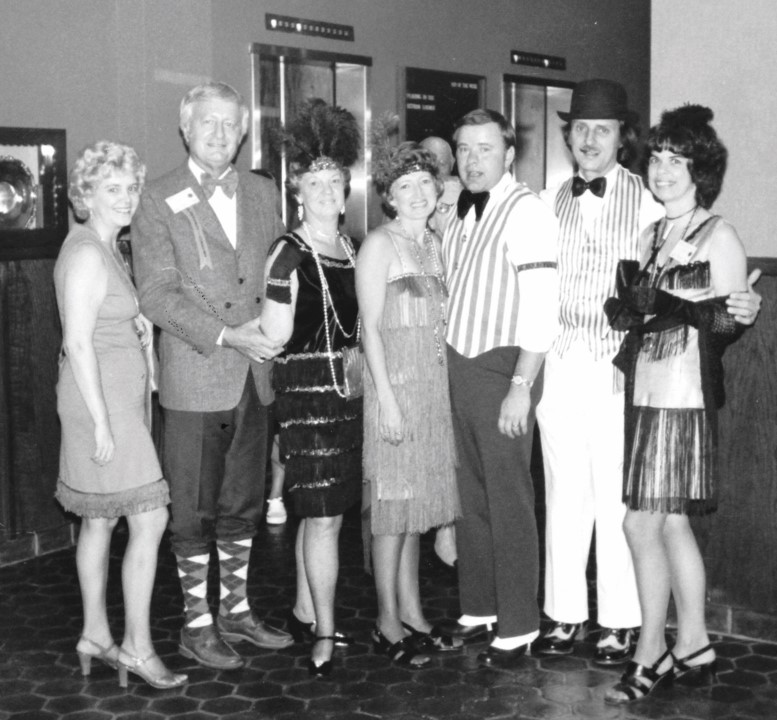
This glass is part of a set commemorating the Society’s 1979 convention in Toledo, marking its 85th anniversary. The convention also marked the formal installation of Frank Dick as the Society’s sixth President and CEO. He is shown in this photo from the 1979 “Roaring ’20s” convention along with Fraternal Vice President Bill Warner, wives Shirley Dick and Sharon Warner, and others.
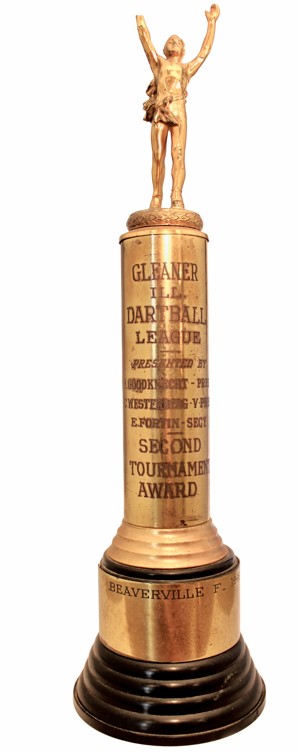
Dartball — a dart game that includes scoring and outs like baseball — was a popular arbor activity. This trophy was awarded to Beaverville F Arbor (IL) in 1946 after it won its second Illinois League championship on April 7. All-Star teams also were chosen. Sulphur Springs Arbor, Illinois, had the two team captains in Kenneth Clark and Sam Douglas.

DuPage Valley Arbor (IL) was represented with this button in 1915, manufactured in Chicago.
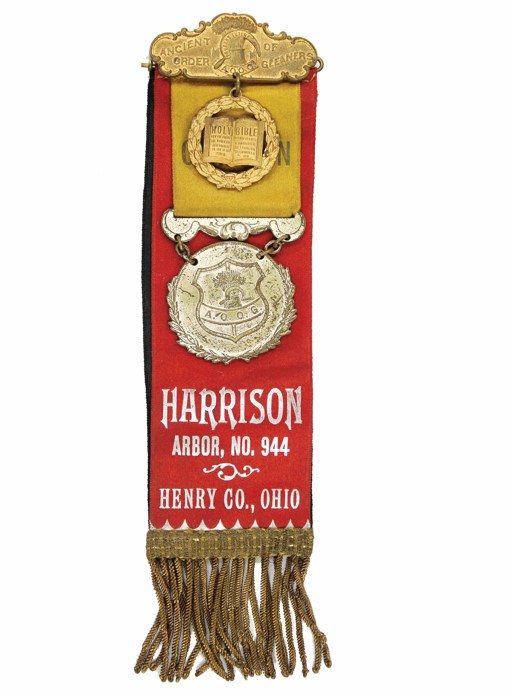
Ribbons such as these were worn at conventions by arbor officers during the early 1900s. This one was for the Chaplain of Harrison Arbor (OH). Similar ones have been found by antique hunters. Nancy Johnson of Sulphur Springs Arbor (IL) recently spotted an Outer Guard’s ribbon from Mohawk Arbor (IL), posted in a Facebook group. Mohawk was one of 10 arbors in Grundy County, Nancy’s husband Carl reported. The symbol of the sickle, included in these medallions, was used less after 1923 when the Soviet Union adopted its hammer and sickle emblem. The Society voted to update its name to Gleaner Life Insurance Society at the 1931 Biennial Convention.










